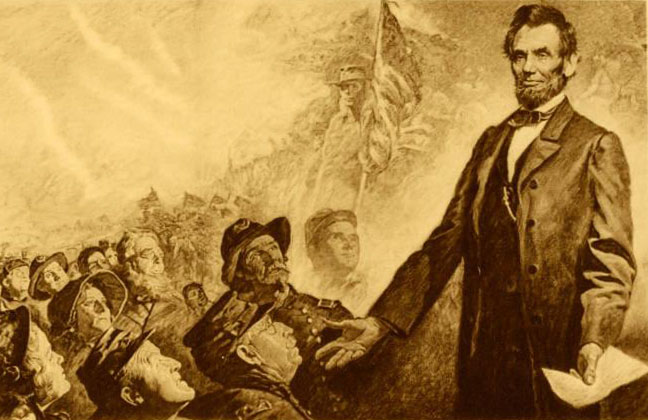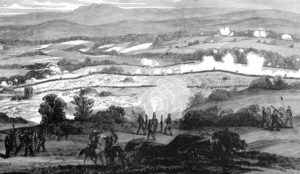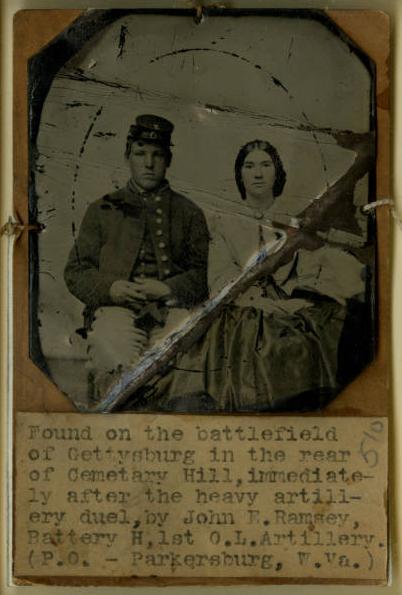Of the People, By the People, For the People: The Gettysburg Address

Delivered on November 19, 1863, the Gettysburg Address remains one of the most important political speeches in our nation’s history. Though brief, Lincoln’s speech that day reached to the core of the nation’s sorrows and fears and hopes, and continues to be studied and revisited.

The Battle of Gettysburg took place from July 1 to July 3, 1863, and was a turning point for the Union forces. Still, the cost of victory was extremely high; it is estimated that casualties numbered near 50,000. For a variety of reasons, mostly relating to the chaos of the three-day battle, it is difficult to determine how many of those casualties were Ohioans. 128 graves lie in the Ohio plot at Gettysburg National Cemetery, but many may have gone unburied or been misidentified. We do know, however, that at least fifteen Ohio units participated in the battle, and that many brave Ohioans fell during the fighting.
Four months later, the Consecration of the National Cemetery at Gettysburg took place. Lincoln’s speech was not the keynote; rather, he was asked to simply contribute remarks to “set apart [the] grounds to their sacred use.” Lincoln’s speech, lasting just minutes, followed a two-hour oration by Secretary of State Edward Everett. It is Lincoln’s words, however, that are remembered today:
Four score and seven years ago our fathers brought forth on this continent a new nation, conceived in liberty, and dedicated to the proposition that all men are created equal.
Now we are engaged in a great civil war, testing whether that nation, or any nation so conceived and so dedicated, can long endure. We are met on a great battlefield of that war. We have come to dedicate a portion of that field, as a final resting place for those who here gave their lives that that nation might live. It is altogether fitting and proper that we should do this.
But, in a larger sense, we can not dedicate, we can not consecrate, we can not hallow this ground. The brave men, living and dead, who struggled here, have consecrated it, far above our poor power to add or detract. The world will little note, nor long remember what we say here, but it can never forget what they did here. It is for us the living, rather, to be dedicated here to the unfinished work which they who fought here have thus far so nobly advanced. It is rather for us to be here dedicated to the great task remaining before us—that from these honored dead we take increased devotion to that cause for which they gave the last full measure of devotion—that we here highly resolve that these dead shall not have died in vain—that this nation, under God, shall have a new birth of freedom—and that government of the people, by the people, for the people, shall not perish from the earth.

Incidentally, though the above text is accepted as the most likely version of Lincoln’s remarks, we are unsure today as to his exact words. Abraham Lincoln Online (not affiliated with Ohio Memory) provides additional information on the speech, as well as five potential transcripts. None varies greatly, however, from that which is shared here.
Ohio Memory holds content related to the Battle of Gettysburg, giving us a sense of Lincoln’s purpose as he addressed the crowd that gathered in November 1863. These include prints depicting the battle, a letter from a serviceman and participant, and photos of Union officers Daniel Edgar Sickles, George G. Mead, Gouverneur K. Warren, and Winfield Scott Hancock. Perhaps most touching and affecting are the tintype photo of a Union soldier and a female companion found on the battlefield and carried to Ohio by John E. Ramsey of the 1st Ohio Light Artillery, Battery H, and Matthew Brady’s photograph of soldiers who had fallen during the battle.
These two, particularly, illustrate the heartache that Lincoln must have felt as he addressed the crowd that day, and are fitting reminders of the reasons we continue to discuss Lincoln’s remarks, the battle, and the war.
Thank you to Shannon Kupfer, Digital Initiatives Librarian at theState Library of Ohio, for this week’s post!



Leave a Reply
You must be logged in to post a comment.